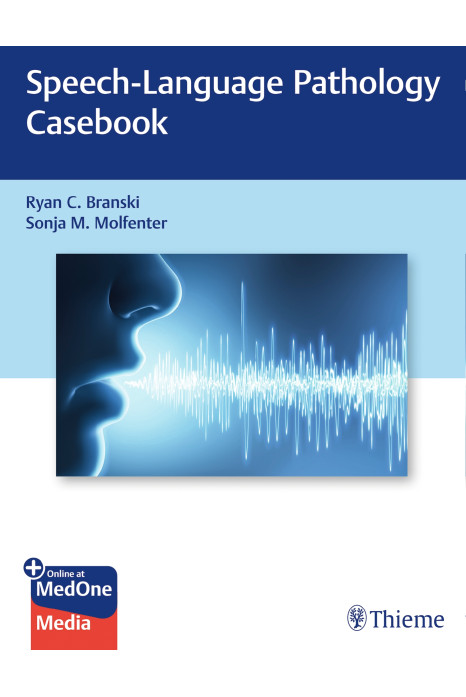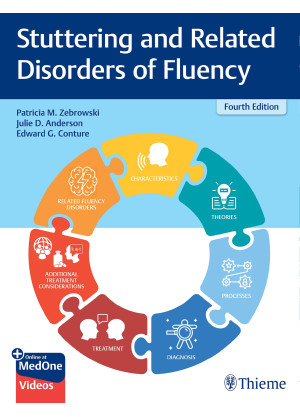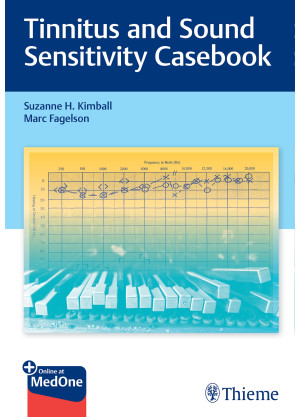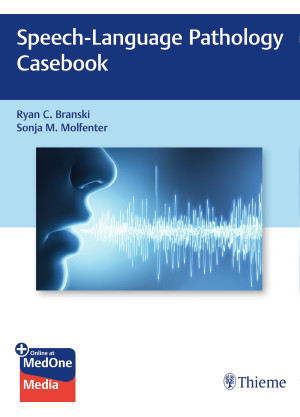Exceptionally insightful speech-language pathology textbook highlights individual cases to augment learning!
Speech-Language Pathology Casebook by Ryan Branski, Sonja Molfenter, and an impressive array of contributors presents a diverse spectrum of cases covering communication, voice, and swallowing disorders in children and adults. Readers are provided with rich and varied narratives underscoring the fact that clinical intervention of speech-language disorders is an art form based on science. Evidence-based assessments and treatments cover a variety of settings including medical inpatient, outpatient, and skilled nursing facility; home health; school; community-based; and private practice.
Eighty cases following a standardized format encompass a wide range of congenital and acquired disorders spanning the age continuum. Each case includes a clinical history and description, evaluations/testing, diagnosis, treatment, outcomes, questions and answers, suggested readings, and references. With invaluable firsthand insights from practitioners, this unique resource enhances the ability to develop effective, patient-informed interventions.
Key Highlights
- Discussion of problems frequently omitted from typical curricula, but increasingly relevant to contemporary clinical practice, ranging from telepractice to transgender voice modification
- Speech-related issues in children associated with cleft palate, autism spectrum disorder, stuttering, bilingual language delays, severe intellectual disability, congenital porencephaly, FASD, apraxia, and many others
- Medical conditions in adults that impact speech-language, such as traumatic brain injury, ALS, right hemisphere disorder, stroke, autoimmune encephalopathy, dementia, Parkinson's disease, autism, and more
- Videos, audio, bulleted key points, and handy comparative charts provide additional pearls
The detailed case narratives enable speech-language students to connect and apply theory and knowledge acquired in the classroom to real-life clinical practice. Instructors and speech-language pathologists will also benefit from this excellent teaching and clinical reference.
This book includes complimentary access to a digital copy on https://medone.thieme.com.
Case 1. Completely Normal Speech Is the Goal for a Child Born with Cleft Palate
Case 2. Assessment and Treatment of Preschool Fluency
Case 3. Working Collaboratively with a Young Child with Autism Spectrum Disorder
Case 4. Clinical Decision Making for a Bilingual Child: Using Converging Information
Case 5. Language Delay in a Bilingual Child
Case 6. The Application of Dynamic Assessment of Narratives in an English Language Learner
Case 7. Stuttering in Young Children
Case 8. Evaluation and Intervention for a Young Child with Severe Intellectual Disability
Case 9. Assessment and Treatment of a School-Aged Speech Sound Disorder
Case 10. Assessment and Treatment of Pediatric Dysphonia with a Complex Medical History
Case 11. Augmentative and Alternative Communication in a Child with Congenital Porencephaly
Case 12. The Importance of Reassessment following a School-Based Individualized Education Plan (IEP) Referral: A Case of Cluttering
Case 13. Prioritizing Communication Supports for an Adolescent with Intellectual Disability
Case 14. Language Impairment in a Child with Suspected Fetal Alcohol Spectrum Disorder
Case 15. Speech Rehabilitation Following Cleft Palate Repair
Case 16. Disorder, Difference, or Gap? A School-Age Disability Evaluation
Case 17. Social Communication Intervention for a Child with Autism Spectrum Disorder
Case 18. Reading Comprehension Difficulties in an Elementary-School Student
Case 19. Childhood Apraxia of Speech
Case 20. Severe Speech-Sound Disorder with Motor Involvement
Case 21. Treatment of Childhood-Onset Fluency Disorder in a High-School Student
Case 22. Language-Based Learning Disability and Literacy in a School-Aged Student
Case 23. Global Language Impairment in a Preschooler with Autism
Case 24. Voice Care for the Child Who Is Post–Airway Reconstruction: Special Challenges
Case 25. Autism Spectrum Disorders and Word Associations
Case 26. Combined Modality Fluency Therapy in a Teenager with Severe Stuttering
Case 27. Pediatric Feeding and Swallowing Impairment in a Child with a Craniofacial Disorder
Case 28. Selective Mutism: A Pragmatic Approach
Case 29. School-Based Swallowing and Feeding Treatment: Oral Phase Dysphagia Secondary to Cerebral Palsy and Moebius Syndrome
Case 30. Early Identification and Early Intervention in the Birth-to-Three Population
Case 31. Treatment of Pragmatic Language Disorders in Preschool and School-Age Children
Case 32. Cognitive Linguistic Deficits in Pediatric Acquired Brain Injury
Case 33. A Holistic Approach to Treating a Preschool-Aged Child Who Stutters
Case 34. Language and Cognitive Deficits Associated with Landau–Kleffner Syndrome
Case 35. Feeding and Language Therapy in a Child with Congenital Cytomegalovirus and Traumatic Brain Injury
Case 36. Psycholinguistic Approach to Assessment and Treatment of Complex Speech-Language Impairment in a School-Age Child
Case 37. Treatment of Communication and Feeding Disorders in a Complex Pediatric Patient with a Neurogenic Disorder
Case 38. Language Assessment in a Child with Minimal Verbal Skills
Case 39. A Profound Phonological Disorder in a Preschooler
Case 40. Childhood Motor Speech Disorders in a Child with 7q11.23 Duplication Syndrome
Case 41. Prioritizing Clinical Decisions in a Complex Medical Case
Case 42. Transfeminine Voice Training
Case 43. Cognitive Rehabilitation following a Severe Traumatic Brain Injury
Case 44. Multiple Unmanaged Concussions in a Collegiate Rugby Athlete
Case 45. Management of Swallow Function in a Patient with an Orocutaneous Fistula
Case 46. Evidence-Based Intervention for Dysarthria in a Patient with Amyotrophic Lateral Sclerosis
Case 47. Rehabilitation of Right Hemisphere Disorder in the Chronic Phase of Recovery
Case 48. Reading as Intervention for a Skilled Nursing Facility Resident with Dementia
Case 49. Speech-Language and Dysphagia Assessment in a Bilingual Female Post Cerebrovascular Accident
Case 50. Accent Modification in a 30-Year-Old L1 Ukrainian Speaker
Case 51. Influence of Cognitive Status on AAC Intervention in a Case of Amyotrophic Lateral Sclerosis
Case 52. Dysarthria Associated with Parkinson's Disease
Case 53. Stroke-Induced, Moderate, Acquired Apraxia of Speech and Nonfluent Aphasia
Case 54. Compensatory and Restorative Application of AAC in Chronic, Severe Aphasia
Case 55. Functional Language Rehabilitation in Nonfluent Aphasia
Case 56. Differential Diagnosis in Spasmodic Dysphonia versus Muscle-Tension Dysphonia
Case 57. Aphasia and Dysphagia in a Resident of a Skilled Nursing Facility
Case 58. Multiple Cranial Neuropathies and Posterior–Inferior Cerebellar Artery Aneurysm following a Traumatic Brain Injury
Case 59. Script Training in Nonfluent/Agrammatic-Primary Progressive Aphasia
Case 60. Hyperkinetic Dysarthria: Dystonic Features in a Patient with a History of Brainstem Encephalitis
Case 61. Exploring Clinician Readiness for Interstate Telepractice
Case 62. Paradoxical Vocal Fold Motion in a High-Level Athlete
Case 63. Accent Modification in a Thai Speaking Graduate Student
Case 64. Conversation Training Therapy for a Professional Voice User
Case 65. Psychogenic Stuttering in an Adult
Case 66. Aural Rehabilitation of a Sequential Bilateral Cochlear Implant User
Case 67. Benign VF Lesions: The Role of Stimulability Testing and Voice Therapy
Case 68. Dystussia and Dysphasia in Parkinson's Disease
Case 69. Injury Prevention for a Touring Professional Singer with Phonotrauma
Case 70. Dysphagia in Generalized Dystonia following Deep Brain Stimulation
Case 71. Speech Therapy Telepractice Program for a Client with Aphasia
Case 72. Linguistic and Cognitive Deficits in Autoimmune Encephalopathy
Case 73. Stroke-Induced Aphasia and Dysphagia: Acute and Long-Term Implications
Case 74. Cognitive Rehabilitation for a Combat-Injured Veteran with Mild TBI and Comorbid Conditions
Case 75. Interdisciplinary Collaboration for Alzheimer's Disease
Case 76. Efficacy of Transcranial Direct Current Stimulation in Posttraumatic Stress Disorder
Case 77. Management of Patients at End of Life
Case 78. Augmentative and Alternative Communication for Broca's Aphasia
Case 79. Utilization of Self-Help Activities for an Adult Who Stutters
Case 80. Targeting Social Communication Skills for an Adult with Autism Spectrum Disorder














